How Google measures up to Apple in all things software
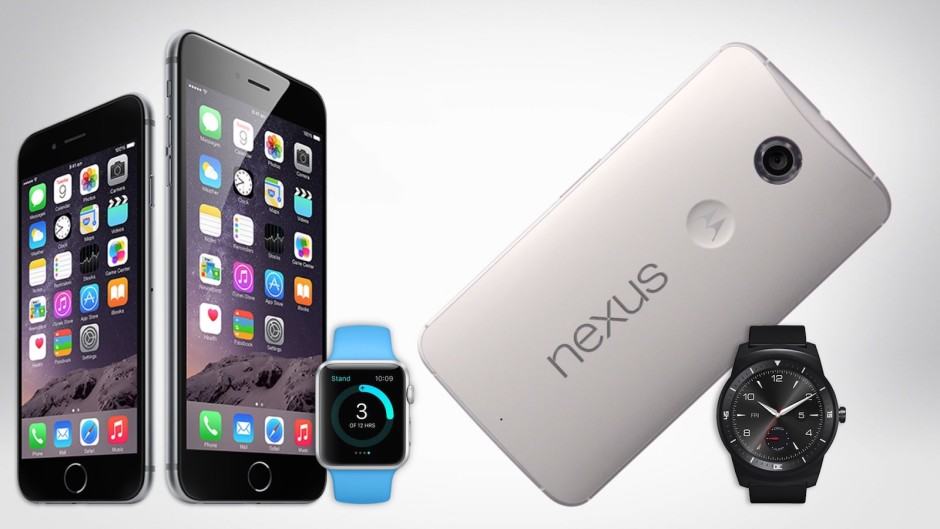
Apple and Google are waging war on all fronts. Photo: Cult of Android
At its I/O conference last week, Google laid out the roadmaps for its most important platforms. It has already made its way into your pocket, but over the next few years, the search giant hopes to find a place on your wrist and in your home as well.
Things aren’t so straightforward as that, though.
Apple is fighting Google for territory in a variety of areas, with iOS competing with Android, Apple Watch battling Android Wear, and HomeKit trying to beat out Brillo.
But which one has the edge that will help it reign supreme? Here’s how they stack up against each other.
Android M vs. iOS 8
Doze
Android M feature Doze might not seem like one of the most exciting features built into the new mobile OS, but it’s going to have a big impact on every Android device you use. And it’s been a heck of a long time coming.
Power management is one of the biggest criticisms about Android. Even super-size smartphones with giant batteries struggle to provide a full day of use between charges, because Android simply isn’t as efficient as it should be.
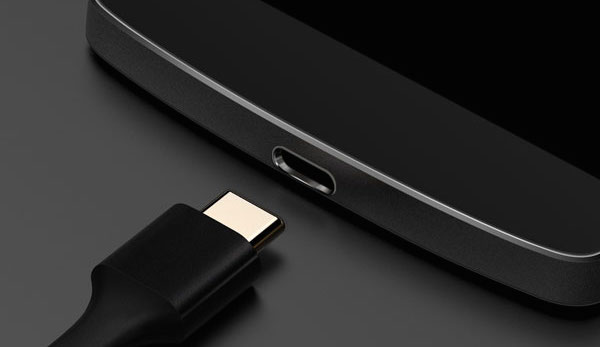
There will be less of this with Android M. Photo: Google
Doze was designed to change that by putting apps into a “deep sleep” when your device is asleep. They cannot access the network. Wake locks — a common cause of battery drain — get ignored and Wi-Fi scans stop. Developers will be able to use high-priority push messages that will wake your device for a brief time so you won’t miss anything important, but most things will be disabled, so nothing will be draining battery life in the background when your device isn’t being used.
As a result, standby times and battery life in general should improve drastically under Android M.
iOS 8 doesn’t have a feature like this, or any other battery-saving modes, but it has always been very good at managing power; iPhones and iPads have long delivered impressive standby times because they are great at gently sipping juice when they’re asleep.
In addition, iOS developers don’t have as much freedom as Android developers do when it comes to background processes, which is one of the reasons Android apps tend to do a lot more — and thus consumer more power — when they’re not in use.
Doze will certainly be a welcome addition to Android M, but it won’t exactly give Android a major advantage over iOS.
There is another feature that will, however.
Google Now on Tap
Google Now has long been better than anything Siri has offered on iOS, and with Now on Tap, it gets even better.
Using Google’s spectacular knowledge graph, Now on Tap recognizes what you’re doing and is there to help whenever you need it. By simply holding down the home button on your Android device, you get access to a contextual menu with useful information and links.
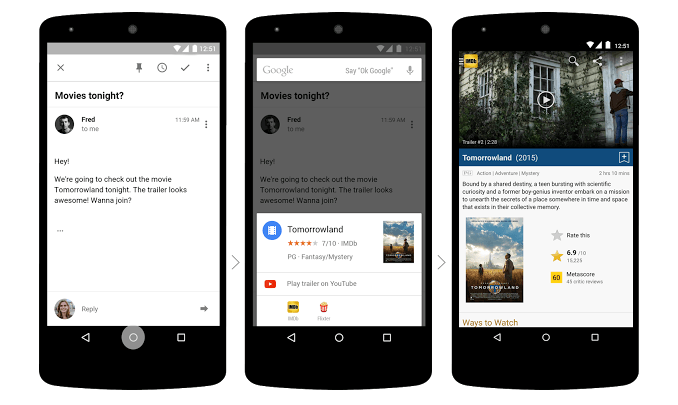
Now on Tap in action. Photo: Google
When you get an email from your best buddy about going to see a movie, Now on Tap can instantly provide you with a link to its trailer on YouTube and relevant pages on IMDb and Flixster. When you get a text about a dinner date, Now on Tap will help you book a table, find the restaurant, and read Yelp reviews.
Summoning this truly intelligent virtual assistance requires nothing but a tap of a button from you, and it’s going to change the way you find information and carry out tasks on your Android device. It’s also going to give Google Now an even greater advantage over Siri.
Siri has certainly gotten better since making its debut on the iPhone 4s back in 2011, but it pales in comparison to Google Now.
Recent rumors have claimed Apple will attempt to take on Google Now in iOS 9. A new feature called reportedly called Proactive will offer deeper system search, augmented reality Maps, and timely information based on user data and usage patterns.
Like Google Now, Proactive is expected to identify upcoming events in your calendar and emails, then provide useful information related to them when you need it. It might detect a flight, for instance, then provide easy access to your boarding pass and updates on departure status.
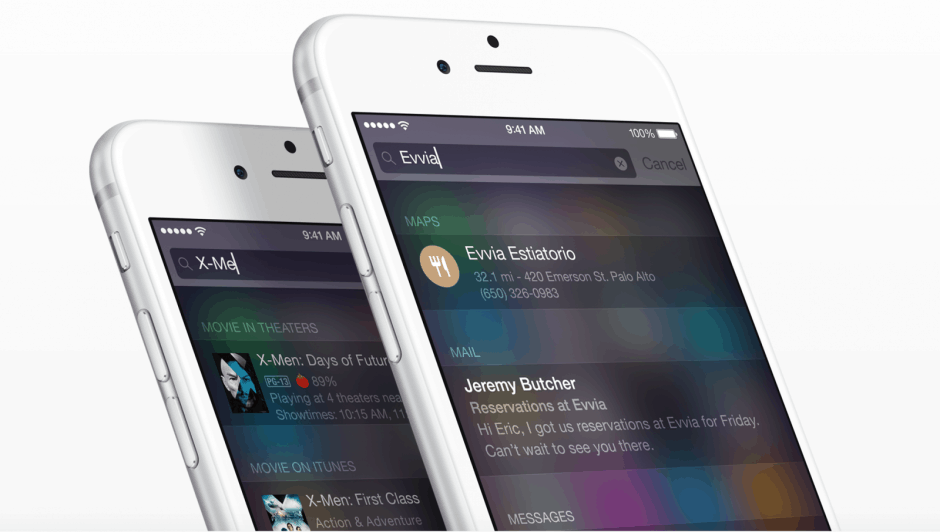
Proactive is to be built into Spotlight in iOS 9. Photo: Apple
It would probably be naive to think Proactive will be as good as Google Now for at least a few years, however — particularly with Now on Tap on the way. iPhone users can only hope Apple’s first attempt at taking on Google Now is better than its first attempt at taking on Google Maps.
App permissions
Google is taking a fresh approach to app permissions in Android M, and like Doze, it’s desperately needed. Right now, Android app permissions are a mess; they’re not easy for the average user to understand, and they’re managed poorly.
So Google is taking a leaf out of Apple’s book. When you install an app or an update under Android M, you’ll no longer see a confusing pop-up that asks you to grant access to a long list of features and data without being completely sure what you’re agreeing to.
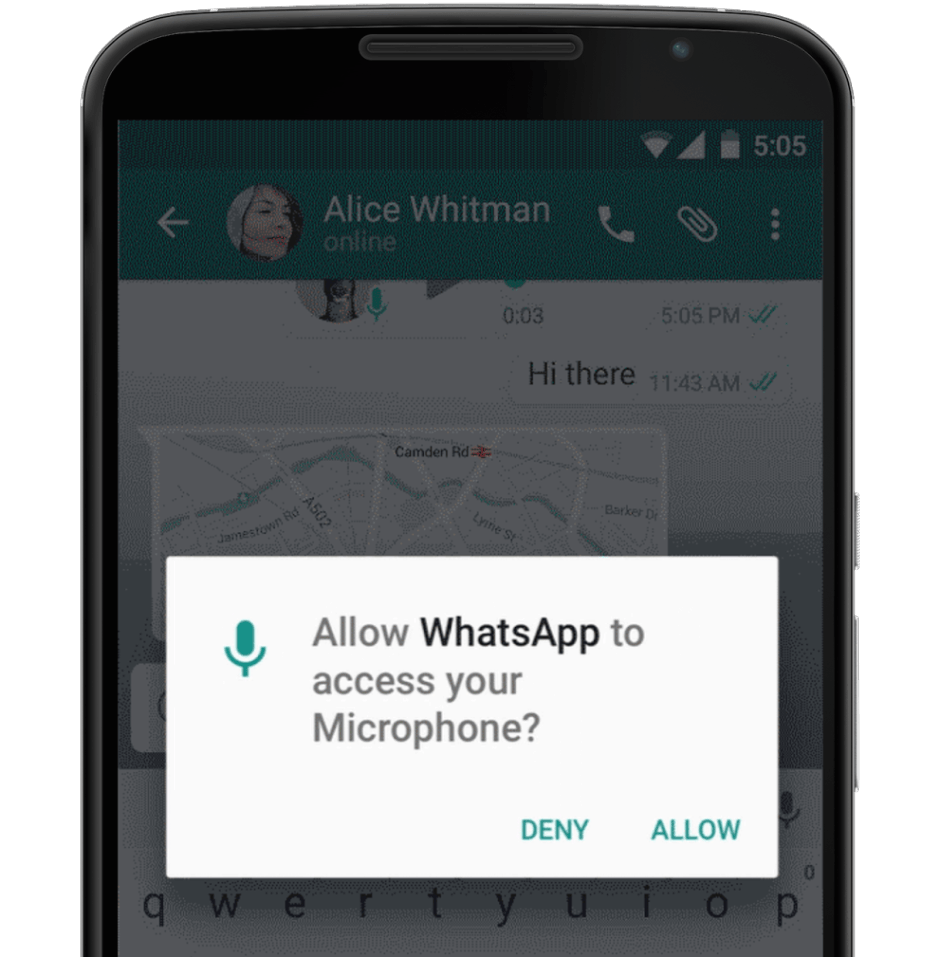
App permissions are getting an overhaul in Android M. Photo: Google
Instead, you’ll be prompted to provide permission for certain things only when apps attempt to use them. For instance, if you download a photo-editing app, you won’t need to grant it access to your photo library until you open the app and need to import an image.
In addition, Android M will allow you to modify permissions much more easily. You’ll be able to toggle individual permissions — such as camera, SMS and location — for individual apps, rather than just allowing or blocking app permissions completely.
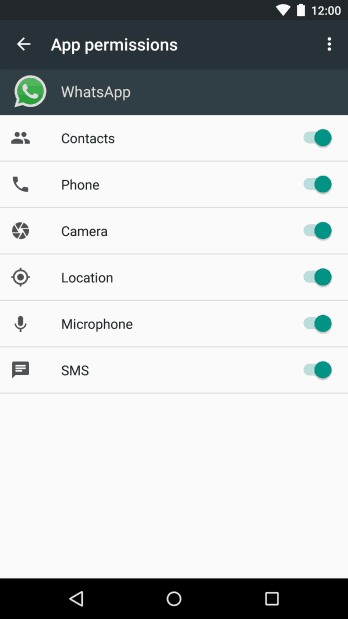
Photo: Google
This also means you’ll be able to change permissions at any time, without having to reinstall or remove apps. If you decide you no longer want a certain app to access location data, revoking its access is as easy as flicking a switch in the settings menu.
In addition to controlling permissions for individual apps, you’ll also be able to go into the permissions themselves and see all apps that have access to them. It takes just a few seconds to see every app that has access to your location and photos.
This is exactly how iOS has handled permissions for some time, and while Android users don’t like to admit that Google copies Apple from time to time, they’ll surely be happy to see the company adopting this approach. It’s immensely better than what Android has now.
Do Not Disturb
Another iOS feature you’ll find in Android M is a Do Not Disturb mode, which silences all incoming notifications — unless you allow “priority” notifications — with the flick of a switch. It’s ideal for meetings, weddings and other events (as well as bedtime).
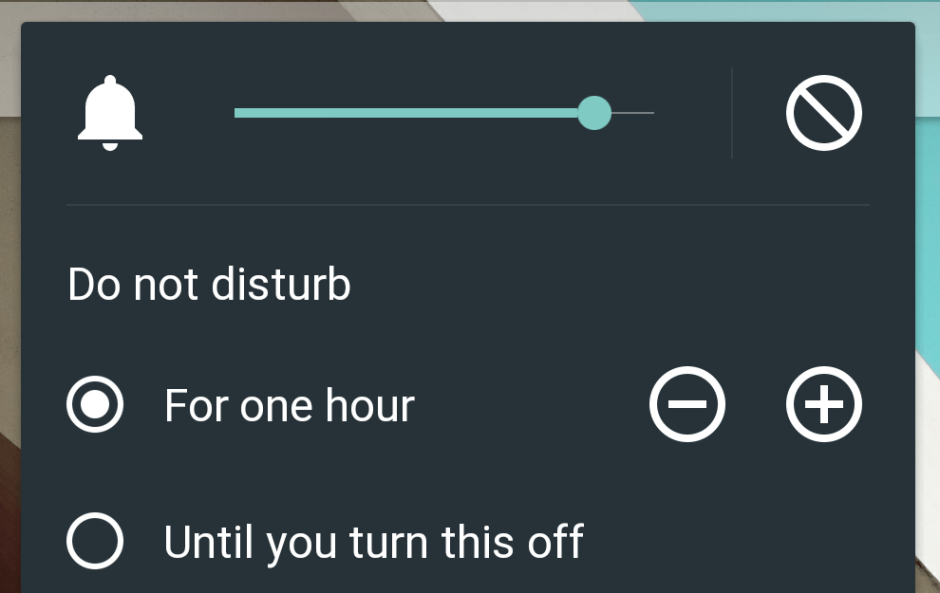
Do Not Disturb is back in Android M. Photo: Google
Do Not Disturb actually made a brief appearance in Google’s Android L preview this time last year, but by the time the update went public, Google had removed it and replaced it with the existing Interruptions system, which many users aren’t all that keen on.
Now it appears Do Not Disturb is set to make a comeback, and it’ll be better than before. In addition to being able to activate it with just a swipe and a tap, you’ll also be able to schedule Do Not Disturb to activate automatically.
Again, this is very similar to the way in which Do Not Disturb works on iOS, though on Android the feature can be used to block everything — including alarms and timers — which it won’t do on iOS. This makes it even more ideal for meetings and the like.
Native fingerprint support
Another major improvement with Android M is native support for fingerprint scanners. You will be able to unlock compatible devices and apps using your fingerprint, and also authorize Android Pay payments with it.
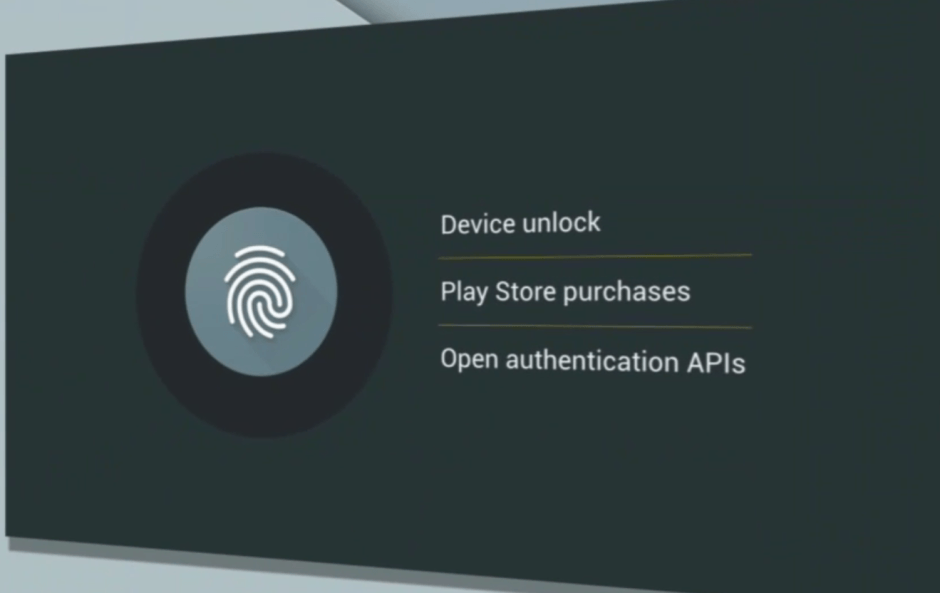
Your fingerprint will do much more with Android M. Photo: Google
Android’s playing catch-up to iOS’ smooth Touch ID feature here, and I couldn’t be more excited about it. It’s going to make the fingerprint scanner built into the Galaxy S6 and S6 edge, the Galaxy Note 4 and future devices even more useful.
Native fingerprint support in Android M all but confirms Google’s next Nexus smartphone(s) will include a built-in fingerprint scanner.
Chrome custom tabs
While not quite as powerful as Now on Tap, Chrome custom tabs is another Android M feature that’ll change the way you use your smartphone — and give Android a leg up over iOS.
Custom tabs are designed to make transitions between apps and web content incredibly seamless, negating the need to switch between apps when you want to read an article you found on Twitter, check out a recipe posted to Instagram, or watch a video shared by SMS.
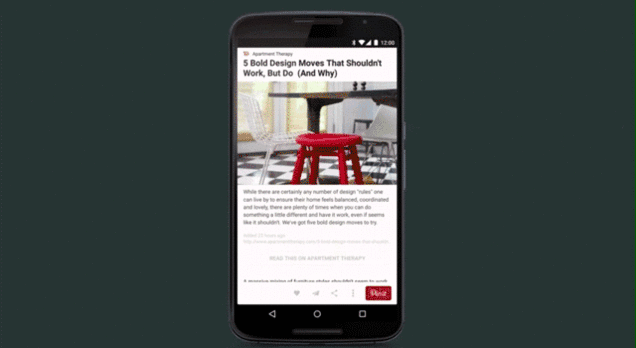
Chrome custom tabs. GIF: Gizmodo
Google says custom tabs are more efficient than traditional WebViews, which don’t share state with your browser and take up extra resources. But using a Chrome tab allows developers to prestart Chrome and prefetch content for faster loading.
It also means your Chrome data can be carried over to the custom tab, so if you open a link to a forum you use frequently, for example, you’ll automatically be logged in because Chrome has your credentials saved.
Apple’s tight control over web browsing on iOS means developers cannot use Safari’s speedy Nitro JavaScript Engine or take advantage of features like Chrome custom tabs. As a result, user must accept a slower, less-efficient browsing experience inside other apps.
Brillo vs. HomeKit
Brillo is Google’s brand new platform for the Internet of Things (IoT). It’s essentially a watered-down version of Android that hopes to unify all of our connected gadgets, including things like smart locks, thermostats, garage doors and even appliances.
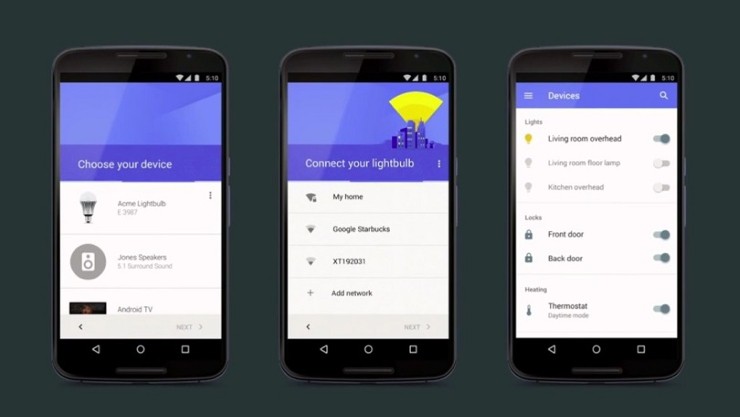
Brillo wants to take over your home. Photo: Google
Sound familiar? That might be because Apple announced a very similar platform called HomeKit at its Worldwide Developers Conference last June, and the two are very common in lots of ways.
Both aim to connect all your smart devices seamlessly, making them easy to control from your smartphone, tablet and other devices. The competing frameworks also allow for nifty things like voice control and location-based triggers, like the ability to turn on lights when you’re close to home.
Google is using a new language called Weave to make this happen, while Apple will make the Apple TV the central hub that all smart devices can connect to. Rumor has it Apple will also deliver a HomeKit app with iOS 9 that will make it easy to control all your IoT devices from one place.
It’s still too early to tell whether Apple or Google has the upper hand when it comes to IoT, because neither Brillo nor HomeKit are available yet. HomeKit will reach the market sooner because Apple’s been working on it a lot longer, and HomeKit-compatible devices are already being made.
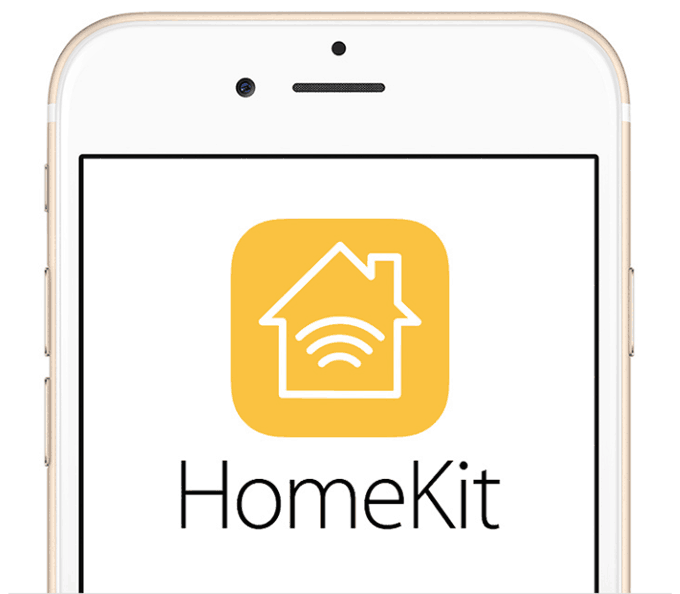
HomeKit is on its way. Photo: Apple
But Google’s acquisition of Nest Labs last year means we’ll almost certainly see the company developing Brillo-compatible smart devices of its own that could come relatively quickly.
Android Wear vs. Apple Watch
Perhaps one of the most exciting battles that will play out between Apple and Google over the next few years will concern wearables: Android Wear and Apple Watch.
Wear has been around a lot longer, but Apple Watch is off to a much more successful start, already outselling all Wear devices that have been released to date. The two platforms are very similar, but Apple Watch offers some distinct advantages.
Health and fitness
When it comes to health and fitness, the Apple Watch beats any other wearable on the market. Not necessarily because it’s the best at tracking, but because it takes fitness much more seriously; it doesn’t just want to record your runs, but help you become a fitter, healthier person.
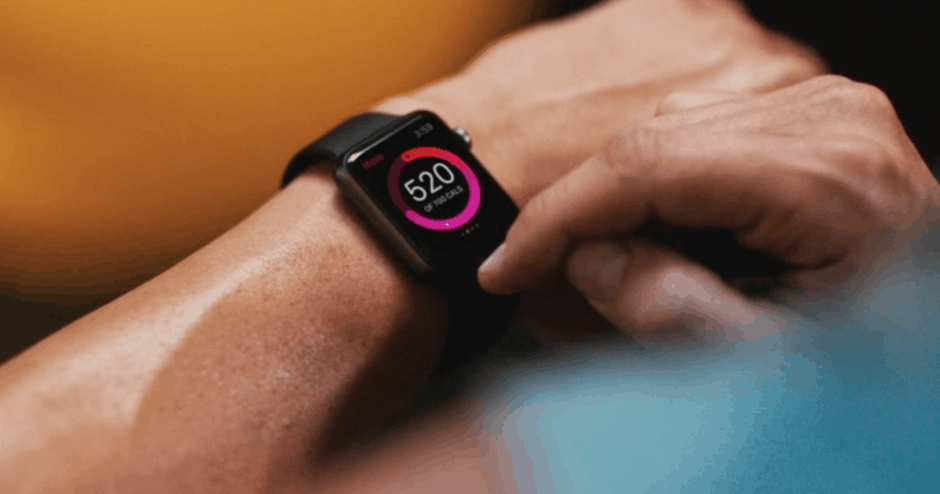
Apple Watch won’t accept laziness. Photo: Apple
The Apple Watch will remind you to stand when you’ve been sitting too long, allow you to set fitness goals you can work toward, and reward you with achievements when you reach them. You can also do a heck of a lot more with the fitness data the Apple Watch records.
That’s thanks mostly to Apple’s excellent HealthKit platform, which is currently unrivaled by Google (or anyone else). Google Fit is little more than a central repository for your fitness data at this point.
If you want a smartwatch that’s going to push you to get into shape, it has to be Apple Watch.
Choice
If you’re not interested in fitness tracking, however, Wear has one thing that might interest you: choice. It’s an open platform, so it runs on a growing collection of watches from companies like Motorola, LG, Asus, Huawei and others.
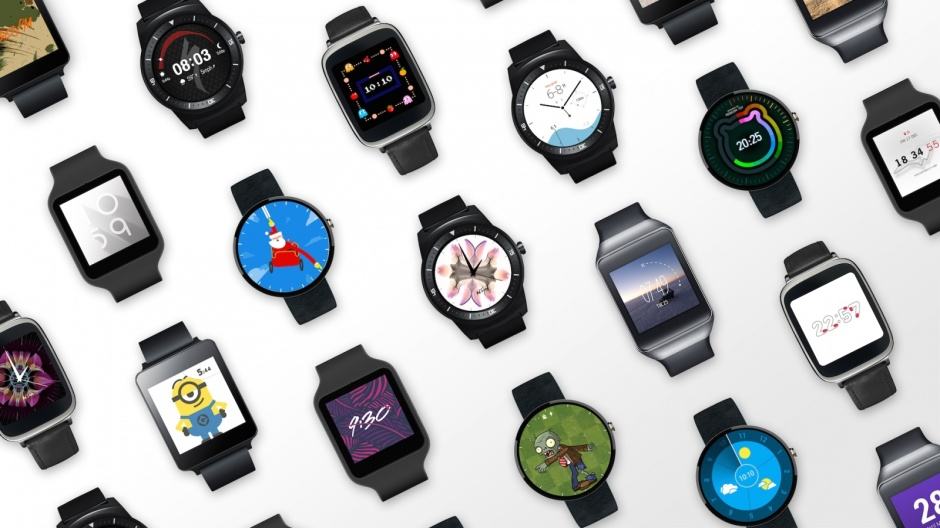
There are plenty of watches and watch faces to choose from with Wear. Photo: Google
You can get Wear watches that are round or square, metal or plastic, and with a whole host of different bands. Most are even compatible with traditional watch straps — they don’t have propriety connectors like Apple Watch.
Google also supports third-party watch faces — there are literally hundreds of them — so you can give your Wear watch almost any look you like. In comparison, Apple Watch users get to choose between the 10 faces Apple provides, though some of them are slightly customizable.
Price
By far the biggest difference between Apple Watch and Android Wear is the price. While the former starts at $349, you can pick up a Wear watch for as little as $99 right now. Even the flagship Moto 360 was just $249 when it first went on sale.
Compatibility
There’s one thing that’s holding Android Wear back, however, and that is its lack of compatibility with iOS. Recent reports promised that Google would deliver iPhone support for Wear devices at I/O, but it never came.
But allowing iPhones to work with Wear watches is the best way to compete with Apple Watch on its own turf. Wear devices might be cheaper. They might be more customizable. And there might be more of them. But they can’t be considered an alternative to Apple Watch without iPhone support.


